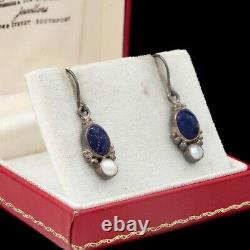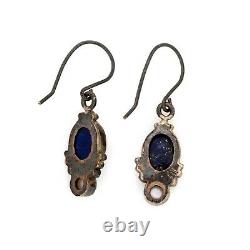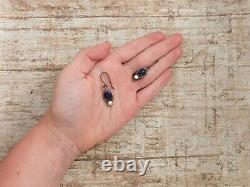
- Vintage Sterling Earrings
- Base Metal
- Brand
- Adastra Jewelry (36)
- Antique (69)
- David Yurman (45)
- Estate (82)
- Florence (38)
- Georg Jensen (83)
- Handmade (174)
- James Avery (36)
- John Hardy (38)
- Mikimoto (34)
- Native American (84)
- Nativo Arts (34)
- Nemesis Jewelry Nyc (50)
- Soviet (44)
- Stephen Dweck (24)
- Sterling (56)
- Taxco (141)
- Tiffany & Co. (200)
- Trifari (23)
- Ussr (169)
- ... (4725)
- Closure
- Cut Grade
- Department
- Ear Area
Antique Vintage Deco Sterling Silver Etruscan Lapis Lazuli Akoya Pearl Earrings





We have similar Etruscan, Lapis Lazuli, and Art Deco items, which would pair nicely with this piece, for sale this week. Listing Description by: Angela A.
Age Circa : Art Deco C. Markings : "925" and faded maker's mark on back of earrings, tested, and guaranteed.
Gram Weight : 4.3 grams. Color: opaque deep blue with mottled darker and lighter blue shades and gold speckling. Stone Treatment: The stone(s) appear to be untreated, but we are not certified gemologists. Stone(s) have been tested and guaranteed using a professional Presidium Duo refractive, heat, and hardness tester. Stone Cuts : Carved and polished cabochon lapis lazuli, naturally rounded and polished pearl.
Earring Backing Style : Shepherd's crook backings. Your jeweler can easily convert these to the preferred backing style you desire. For Pierced or Non-Pierced Ears : Pierced. Handmade in the Art Deco era in the Etruscan Revival style. These earrings are composed of. Each earring features a lapis lazuli stone with a deep blue hue and mottled lighter and darker blue shades, as well as the gold-hued speckling prized in this variety of stone. Beneath the lapis lazuli stones rest Akoya pearls, their lustrous white hues contrasting beautifully with the lapis lazuli. Granulated silver beads also adorn the earrings in classic Etruscan Revival style. The earrings are completed with shepherd's crook backings for secure wear on pierced ears. There is tarnish on the silver which gives the earrings a lovely antique quality. The price has been reduced to reflect this. This listing is for the item only. The Art Deco era is famous for being the "Gatsby" or "Roaring Twenties" era. A lot of gorgeous and timeless designs in jewelry came out of this period. Jewelry from this period was most often crafted between 1920 and 1940. Art Deco jewelry sometimes featured white gold or platinum, geometric designs, European cut diamonds, filigree, and calibre cut stones that are specifically cut to fit the design of the piece. During the Art Deco period jewelers often made jewelry upon custom order, this would often take weeks to months to completely craft by hand. Etruscan Revival jewelry was first popularized during the early 1800s when an Etruscan tomb was discovered just outside of Rome.Upon its discovery, jewelers worked to imitate and understand the metalworking techniques with which the jewelry was made. Not only was Etruscan jewelry a luxurious addition to the Victorian styles of the day. But it introduced new ideas and decorations. These Etruscan tombs contained jewelry adorned with long and flowing geometric lines and motifs, mythological imagery and scenery, and celestial elements.
The techniques of repoussé, filigree, and granulation are all attributed to the Etruscans. Prized for its intense blue hue and unique gold speckling, lapis lazuli has been mined since approximately 7000 BC. Some of the oldest and finest lapis lazuli mines can be found in Afghanistan, particularly in the Badakhshan province, where several mines are still in operation. From the Indus Valley Civilization to the ancient Egyptians and artists of Medieval Europe, lapis lazuli has been a highly prized and sought after stone. Popular not only in jewelry, lapis lazuli was also ground into powder by Renaissance artists, who used it to create the expensive ultramarine blue pigment used in oil paintings.
Throughout human history, lapis lazuli has been carved and crafted into stoneware, jewelry, and other decorative items. Its rich blue pigment and eye-catching gold speckling make the stone highly prized in antique and modern jewelry alike. Akoya saltwater pearls are cultured from the Akoya oyster and can be found primarily in Japan and China. They are known for their beautiful round shape and exquisite luster that sets them apart from many other types of pearls.
They are usually white or cream in color but can have rose or silver undertones. During the Art Deco era, Akoya pearls were rare, expensive to own, and reserved for the richest of the rich. The item "Antique Vintage Deco Sterling Silver Etruscan Lapis Lazuli Akoya Pearl Earrings" is in sale since Saturday, July 4, 2020. This item is in the category "Jewelry & Watches\Vintage & Antique Jewelry\Fine\Art Nouveau/Art Deco 1895-1935\Earrings". The seller is "abeautifultimeco" and is located in Fort Collins, Colorado.
This item can be shipped worldwide.- Stone #2: Akoya Pearl
- Modified Item: No
- Country/Region of Manufacture: Unknown
- Style: Drop/Dangle
- Metal Purity: .925
- Main Stone: Lapis Lazuli
- Metal: Sterling Silver
- Jewelry Department: Fine

